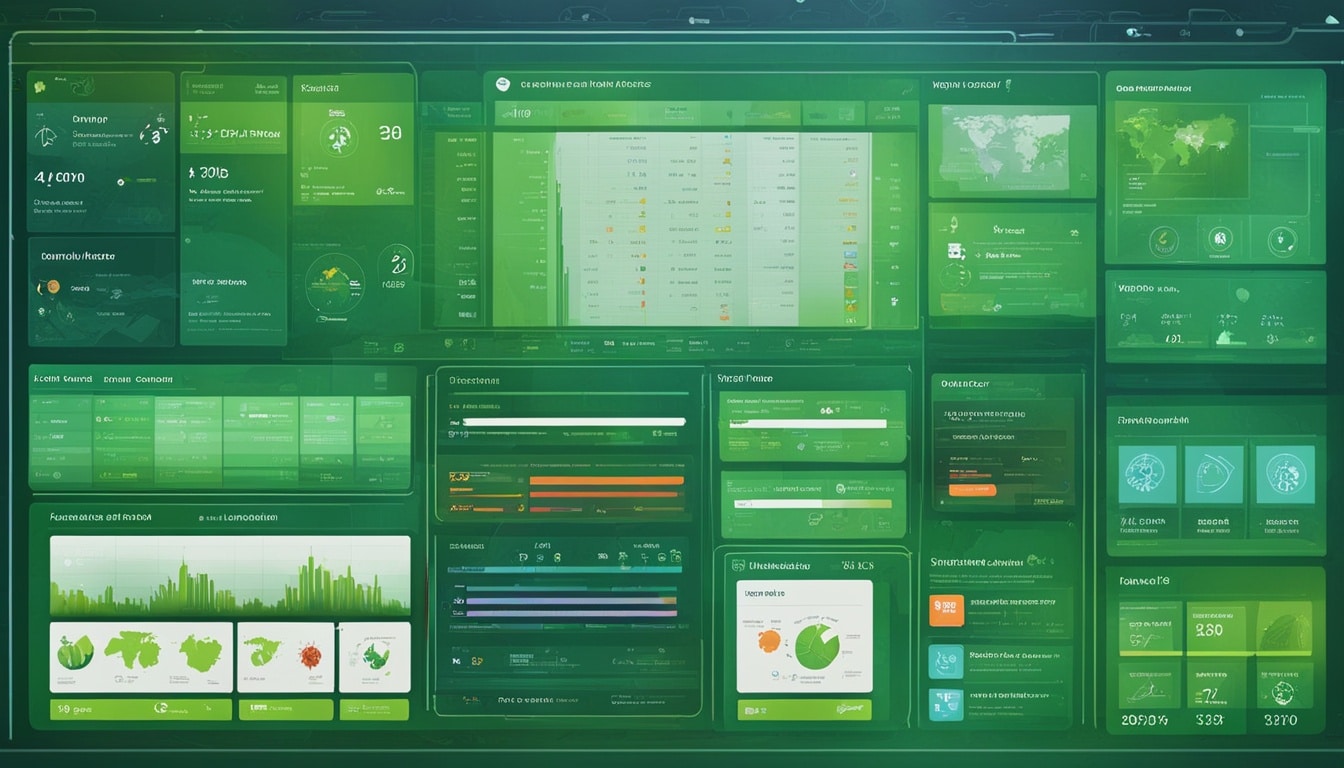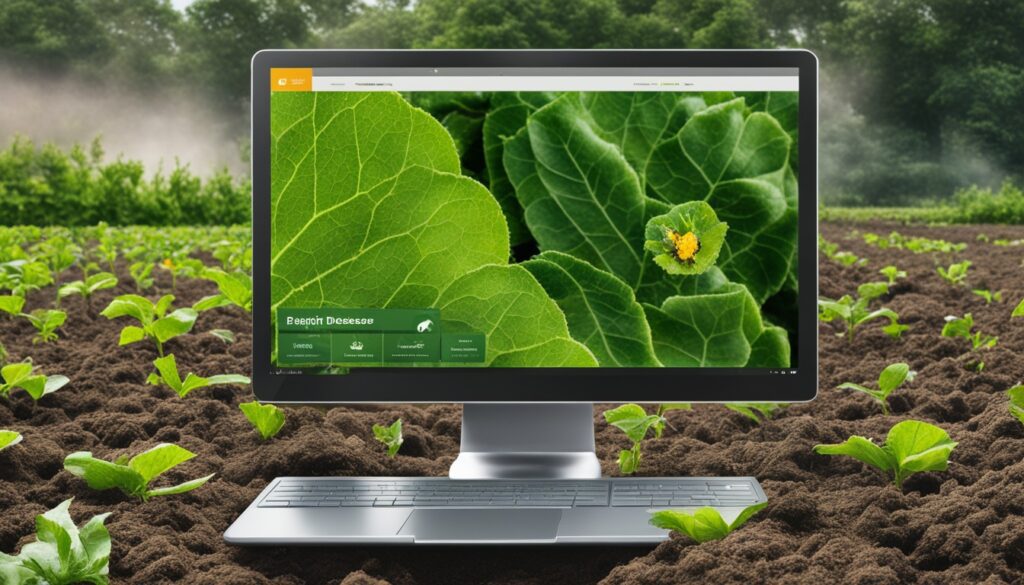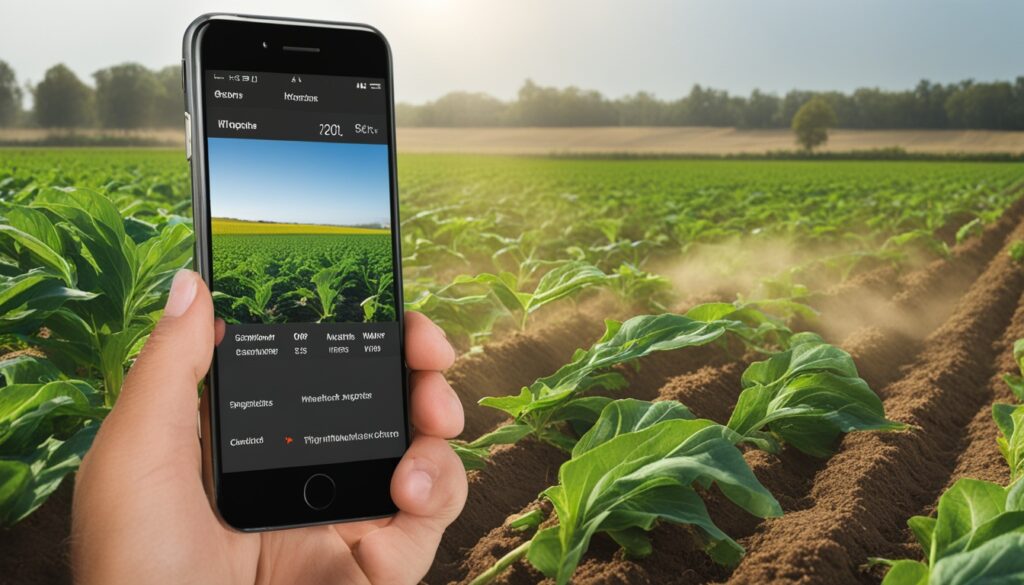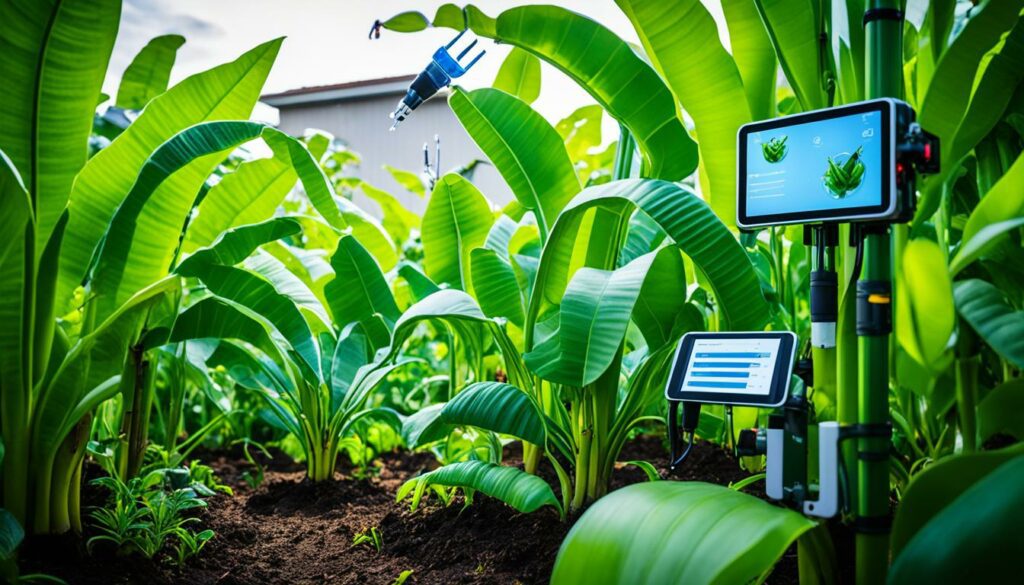Menu

Global crop production loses around 20-40% a year to pests and diseases. This shows how important it is to have good ways to manage them. Today, farming is getting more high-tech. This is especially true when it comes to dealing with pests and diseases. If left unchecked, these can heavily affect crop growth and the economy.
Digital tools are key in fighting these challenges. They bring new ways to keep an eye on and deal with pests and diseases. Farmers can use these tools to protect their crops better and get higher yields.
The mix of tech and farming is changing, especially with digital pest and disease tools. This new wave uses digital methods to check crop health. It helps find threats early and manage pests better.
Crops worldwide are hit hard by pests and diseases, losing up to 40% every year. This is a big issue in places without enough food. Many threats like cassava viruses, locusts, and fall armyworms affect crops. This shows we need strong ways to manage pests.
But, some places are slow to spot these problems. This delays fight-backs, especially for cassava in Africa. Apps such as PlantVillage Nuru spot these diseases quickly. They help predict how crops will do.
Working with researchers, these apps now cover more crops like potatoes. They use AI to watch over crops closely. This high-tech help is much better than old ways, cutting back on pesticides.
| Technology | Application | Benefit |
|---|---|---|
| AI Applications (e.g., PlantVillage Nuru, Tumaini) | Recognising and Predicting Crop Diseases | Rapid Response, Accurate Diagnosis |
| Remote Sensing | Crop Health Monitoring | Reduced Pesticide Use, Enhanced Efficiency |
| GIS Technology | Create Maps of Pest Trap Counts | Improved Predictive Capabilities |
Mapping pests with GIS helps see where they might spread. Weather tech also predicts pest invasions. It looks at things like humidity. Cameras help gather more data over time.
Digital pest controls use lots of tools to fight off pests better. They help make smart decisions. As we use and improve these techs, we can protect crops more.
Spotting pests and diseases early is key to avoiding big losses and keeping farms productive. Using modern technology helps farmers catch problems before they get out of hand.
When pests and diseases hit, farms can lose a lot of money. Every year, the world’s crop output takes a hit. Finding and dealing with these issues quickly is vital to cutting down on costs and making sure we have enough food.
Digital tools are changing how we find and handle pests and diseases. New technologies, like AI and deep learning, can spot problems with up to 104% accuracy. This means farmers can act fast against any threats they spot.

Systems that use AI and the Internet of Things are proving very effective. They can detect pests with an accuracy of 180750 to 180761. Integrating these technologies into farming can lower the amount of crops lost and boost farm production overall.
High-tech tools, like satellites, are also helping with early disease detection. They can pinpoint problems in crops very accurately. This gives farmers the exact information they need to make smart, quick choices in managing pests.
In conclusion, using digital tools for early detection is hugely important for our economy. These tools give farmers the power to be proactive, keeping their crops healthy and their businesses strong.
The use of AI-based pest monitoring is changing how we look after crops. These systems use smart image tech to check on crop health. They can spot early signs of pests or diseases, so farmers can act quickly and smartly.
AI tools for pests are smart. They can process lots of data quickly. This means they can see small crop changes that might mean pests are coming. The IoT technology helps by constantly collecting and checking data.
These tools can connect in many ways like LoRaWAN and Wi-Fi. This makes sure data flows well from the field to the main system. The data can then be stored in the cloud and checked by farmers anywhere.
AI-based pest monitoring is great at giving fast updates. It can find problems quickly and tell farmers fast. This lets farmers handle problems early, stopping them from getting worse.
These systems work well with other tech like robots and drones. They use smart irrigation and farm on their own. Even though using AI can be tricky, the good is worth it. It saves money, uses resources better, and helps farms work smarter.
| Technology | Function | Benefits |
|---|---|---|
| Image Recognition | Detects early signs of pests | Early intervention, reduces damage |
| IoT Integration | Real-time data gathering | Enhanced productivity and efficiency |
| Cloud-based Systems | Data storage and analysis | Access insights anytime, anywhere |
| Robotics & Drones | Precision farming techniques | Improved resource management |
Mobile apps are changing how farmers fight crop diseases. Tumaini and PlantVillage Nuru lead this change. These apps use AI to spot diseases in crops by just taking a photo.

Apps like Tumaini and PlantVillage Nuru are big hits with farmers worldwide:
These apps help farmers in many ways:
PlantVillage Nuru is a game-changer in spotting plant diseases. This smart app uses TensorFlow, a tech by Google. It quickly tells what’s wrong with crops, thanks to 200,000+ images it’s learned from.
The heart of PlantVillage Nuru is its smart AI. It can tell diseases apart, like cassava mosaic disease, through a huge image database. With fast data processing, it boosts how we watch over and make decisions about crops.
PlantVillage Nuru isn’t just for cassava; it helps with potato troubles and maize bugs too. It spots problems early, telling farmers the best fix. This has upped crop yields by 146% and incomes by 55%. Plus, it’s good for nature and society by making farm info more available.
| Impact Metric | Outcome |
|---|---|
| Estimated Users at Inception | 30 |
| Estimated Users at Last Report | 400 |
| Revenue Increase | 55% |
| Yield Increase | 146% |
| Accuracy vs Extension Workers | Twice as accurate |
| Women and Youth Participation | Increased |
The Tumaini app is a game-changer for banana disease care. It uses artificial intelligence to spot and tell apart six major banana diseases. This method works very well, making a big difference in farming.

The app has over 18,000 photos from fields, all approved by banana experts. It’s great at catching diseases like Fusarium wilt, which harms banana plants worldwide. This vast image collection makes the app very flexible, working well with all kinds of plant photos. It’s this ability that helps farmers get quick and accurate information, crucial for good farming.
The Tumaini app is now used in many places, doing a lot to control banana diseases. It’s especially important in areas with a lot of people and not enough food. There, it helps cut down the huge amount of crops lost each year to pests and diseases. The app’s use leads to better farming and helps make sure there’s enough food for everyone.
| Aspect | Details |
|---|---|
| Success Rate | 90% |
| Disease Identification | Six Major Banana Diseases |
| Image Dataset | 18,000+ Field Images |
Unmanned aerial vehicles, or UAVs, are becoming more common in agriculture. They help with managing pests by monitoring and fighting against them. This use is especially important as crop pests and diseases could reduce global grain production by 10-16% each year. In China, these issues cause about 40 million tons of grain loss annually. So, the need for better pest management is clear.
Satellites are useful but struggle with spotting pests and diseases up close. They see big areas but with less detail. This is where UAVs shine. They offer up-to-date information, taking close-up pictures and monitoring crops as needed. Such fast responses from UAV data help farmers fight pest outbreaks quickly. It prevents or lowers the economic harm caused by these troubles.
The Food and Agriculture Organization of the United Nations (FAO) says over 37% of the world’s crops are lost yearly to pests and diseases. UAVs, with their special sensors and cameras, could change this. But, they face some challenges in large farms, like limits on how much they can carry and battery life. However, their growing use suggests a big change in how we manage pests on farms.
Pests and diseases cause a lot of money to be lost in farming. In India, due to fall armyworm, the losses are big, about 34% of the yield. Yet, as we use more UAVs, our ability to fight these problems gets better. New tech like thermal sensors and very detailed images means we know more, helping us get rid of pests better and do farming in a way that’s kinder to the environment.
The growth of UAVs for pest control shows us how important new tech is in farming. With better and better technology, drones can give farmers the information they need to protect their crops. This helps ensure there’s enough food for everyone around the world.
In agriculture, remote sensing has changed how we keep an eye on crop health. It uses sensor technologies to spot diseases and pests. This helps us protect our crops, ensuring there’s enough food.

Today, a wide range of sensors help us in agricultural monitoring. They capture everything from gamma rays to microwaves. This technology is great at telling diseases and pests apart. Multispectral and hyperspectral imaging are leading the way in this field.
Multispectral cameras look at plants in various wavelengths. This helps find out if there are pests around. On the other hand, hyperspectral sensors look at plants in hundreds of tiny wavelength bands. They give us lots of detail about a crop’s make-up. This detail helps spot specific diseases.
New technologies in remote sensing are bringing us better ways to fight crop diseases. These tools use machine learning and lots of sensor features. Some of these include VIS-NIR spectral data, fluorescence, thermal readings, and image properties.
Thanks to advanced remote sensing, spotting crop diseases accurately is improving. This is done through techniques like support vector machines and deep learning. They let us find and tell different diseases and pests apart.
Remote sensing combined with UAVs is taking surveillance to new heights. These drones keep an eye on crops from above. They collect lots of data, which is crucial for fighting forest pests. The data helps track pest numbers with amazing accuracy.
| Sensor Type | Applications | Advantages |
|---|---|---|
| Multispectral | Vegetation indices, crop health monitoring | Effective in identifying pest-induced variations |
| Hyperspectral | Biochemical and structural analysis, disease identification | Comprehensive and detailed spectral data |
| Thermal | Stress detection, irrigation management | Detects temperature differences indicative of stress |
In conclusion, remote sensing with its high-tech sensors is key in agricultural pest surveillance. With technology always improving, our monitoring tools get better and better. These innovations are critical in the ongoing fight against agricultural pests and diseases.
Digital tools combined with traditional Integrated Pest Management (IPM) systems lead to big improvements. Farmers see better results in managing their crops. This mix brings many benefits to pest control.
Bringing digital technology into IPM offers several advantages:
There are many examples showing the success of merging digital tools with IPM:
| Application | Crop | Technology Used | Impact |
|---|---|---|---|
| PlantVillage Nuru | Cassava | AI & Image Recognition | Rapid disease identification, trained on 200,000 images |
| Tumaini | Banana | AI & Image Analysis | 90% success rate in disease detection over 18,000 field images |
| Rentokil PestConnect | General Pest Monitoring | IoT & Infrared Sensors | Real-time monitoring and alerting |
| Anticimex SMART | Rodents | Prediction Algorithms | Predicts rodent populations based on detections |
Partnerships with research and other organisations have made AI more widespread. This helps farmers and workers make good use of digital tools.
A mixture of digital and old methods powers modern IPM work. It supports sustainable, productive farming across the world.
Digital pest control tools offer big chances, but they face several issues. The key is to fix tech problems in agriculture and make sure everyone can use these tools. This way, their benefits grow.

Farming’s tech issues are a big challenge. Tools needing strong internet and expensive devices are tough to use in remote places. For farmers not so tech-savvy, the tools can be hard to understand. Limited research and development also hurt, especially for solutions supposed to work with nature.
Getting digital tools to farmers in developing areas is often hard. The cost and lack of awareness keep many farmers from using them. This stops the spread of good pest control practices. Globalisation makes it worse by spreading pests fast. Combining old and new methods is helpful but not common yet.
To help, letting communities take the lead and share ideas is key. Also, giving farmers reasons to use these new methods is important. Using tech to educate more people can make a big difference. This way, everyone can benefit from better pest management.
| Challenge | Impact |
|---|---|
| Technological Limitations | Restricts use of advanced tools |
| Access to Digital Farming Tools | Hinders adoption in developing regions |
| Lack of User-Friendliness | Complicates utilisation by farmers |
| Globlisation of Invasive Pests | Challenges in containment efforts |
In farming, tools for precise pest management are becoming more critical. They allow farmers to find and solve pest issues with amazing accuracy. This means better protection for crops and higher yields.
Many special tools have been made to fight pests better. These include:
Using these tools doesn’t just make fighting pests better. It also improves how we look after crops in general. Here’s why:
They want to use fewer chemicals and more smart tools in just the right places. This saves good bugs and keeps nature healthy, fitting with a goal called integrated pest management.
High-tech systems link data on pests in real time with how crops are doing and the weather. This mix lets farmers guess when pests will be worst and how big the risk is over a wide area. Knowing exactly what’s happening on their land helps them choose the best ways to fight pests. This saves time and money, leading to bigger harvests.
Also, using precision tools helps catch pest problems early. So, farmers can act fast to stop them hurting the crops a lot. This can avoid big losses in crops and money.
| Technology | Usage | Benefits |
|---|---|---|
| GPS | Creating management zones | Precision in pest control |
| Sensors | Pest identification | Accuracy in monitoring |
| Automated Traps | Capturing pests | Reduced labour, consistent data |
| Drones | Aerial monitoring | Early detection from above |
| Satellite Technology | Wide-area surveillance | Identifying outbreaks |
| Robots | Pesticide application and monitoring | Precision and continuous oversight |
Modern digital tools are key in moving away from chemical pesticides. They use data analytics and new tech to manage pests safely. This helps keep the environment healthy and crops safe.
Digital tools cut down on using chemical pesticides. For example, the PlantVillage Nuru app can quickly spot diseases in crops. It uses a vast database to make accurate diagnoses. This means farmers can act fast without relying too much on chemicals.
The Tumaini AI app is great at spotting diseases in bananas. It uses a huge collection of field images. Because it can detect diseases well, it means farmers only need to use pesticides when it’s crucial. This stops them from using too many chemicals.

Digital tools do more than just watch for pests. They actively push for eco-friendly ways to manage pests. Projects like the one between PlantVillage, the CIP, and FAO work together to fight threats without chemicals. They focus on specific problems, like the maize fall armyworm, using green methods.
They also use high-tech sensing from above and on the ground. This makes it easier to keep an eye on diseases and pests. By being very precise, they use fewer resources and do less harm to nature.
Precision agriculture techniques offer astonishing potential in reshaping pest management frameworks, ensuring that interventions are environmentally sustainable while effectively safeguarding crops.
| Technologies | Impact on Sustainable Practices |
|---|---|
| AI-based Disease Recognition | Enhanced early detection and precise interventions, reducing pesticide use. |
| UAV Surveillance | Comprehensive monitoring capabilities, promoting targeted and eco-friendly treatments. |
| Multilevel Sensing Systems | Efficient disease surveillance leading to minimal environmental disruption. |
The way we manage pest diseases is quickly changing. New technologies are making farming more efficient. These changes will truly transform how we handle pest and disease control.
Today, artificial intelligence (AI) and deep learning (DL) are changing the game. They help spot bugs using advanced tools like convolutional neural networks (CNNs). These networks outdo people in spotting invading bugs, thanks to different CNNs working together.
Machine learning models are also better at identifying pests. For example, the HGS-DCNN model is more accurate. This is vital for controlling pests with look-alike features in different places.
Digital tech like spectral remote sensing is aiming to make managing pests better. It can pinpoint which plants are hurt and where pests are. This info helps use less pesticide and more specific non-chemical methods. This is known as precision pest management.
AI-powered apps like PlantVillage Nuru and Tumaini are big in disease spotting. PlantVillage Nuru can diagnose cassava diseases instantly, and it’s even helping with potatoes and maize. Tumaini hits an outstanding 90% in disease identification. These apps are a game-changer for farmers.
Using these new tech trends could really boost farming. With AI, machine learning, and IoT, we’re moving towards better crop protection. This new agriculture era will be more effective, eco-friendly, and ready for the future’s new pest challenges.
| Technology | Application | Impact |
|---|---|---|
| AI & DL | Insect Pest Detection | Higher accuracy, surpassing human experts |
| Remote Sensing | Pest Population Management | Reduction in pesticide use, precise targeting |
| AI-Powered Applications | Disease Diagnosis | Rapid and accurate disease identification |
The field of pest and disease management is changing fast. Technology is playing a huge part in this, making our fight against these issues more effective. Digital tools are now helping us deal with up to 40% of crop losses every year, caused by pests and diseases.
Apps like PlantVillage Nuru and Tumaini show what digital tech can do. They help farmers spot diseases early, using big databases of plant images. This quick reaction protects crops, especially in places where spotting problems can be slow.
Combining new digital methods with the old ones, like IPM, is working well. It means less pesticide use and saving the good bugs that fight pests. This approach is kinder to the environment and uses resources better.
Using digital ways to manage pests and diseases really matters. It keeps crops healthy and our economy strong. Moving forward, these digital tools are key for farming to be sustainable and keep up with the changing world. They’re essential for the future of feeding the planet.
Digital tools for managing pests and diseases use the latest tech. They keep track of threats and help stop them. This helps farmers a lot by giving them up-to-the-minute info.
Digital pest control makes integrated systems work better. They use data to track and fight pests, working hand in hand with old methods. This means better and greener pest control.
Early spotting of pests or disease is key. It stops damage early, saving money and crops. Digital tools are great at finding problems fast.
AI systems recognise pests and diseases from the look of plants. They give farmers quick info and tips. This helps farmers act fast to save their crops.
Tumaini and PlantVillage Nuru are top apps for spotting crop diseases. They use AI to check pictures of plants. They give farmers advice to keep their crops healthy.
PlantVillage Nuru quickly identifies plant diseases with TensorFlow. It learns from lots of picture data to make accurate calls. This helps farmers to make the right moves to protect their plants.
The special Tumaini app is very good at finding banana pests and diseases. It can handle all kinds of picture qualities. This makes it super helpful for farmers everywhere.
Drones watch over big fields with smart sensors. They’re great for keeping an eye on pests and checking crop health. This helps farmers target their pest control efforts.
For spotting diseases, we use cameras with extra-sensing powers. These tools look deep into crop health to fight threats better. They’re key for smart pest and disease control.
Combining digital and old methods improves how we control pests. It’s better for the farm and the environment. This new mix boosts how much food we can grow safely.
Digital pest tools can’t help everyone if they aren’t available to all. Making sure everyone can use them is crucial. Then, their benefits can reach more farmers.
Precision tools include sensors that can find pests up close. They help farmers fight pests right where they are. This makes looking after crops easier and more effective.
Digital tools are less about chemicals and more about smart prevention. They use data to predict and prevent pests. This keeps fields safe and the planet too.
The future is bright with new tech like AI and IoT. These will change how we protect our crops, making farming better and safer for the world. It’s a big step towards feeding the planet.